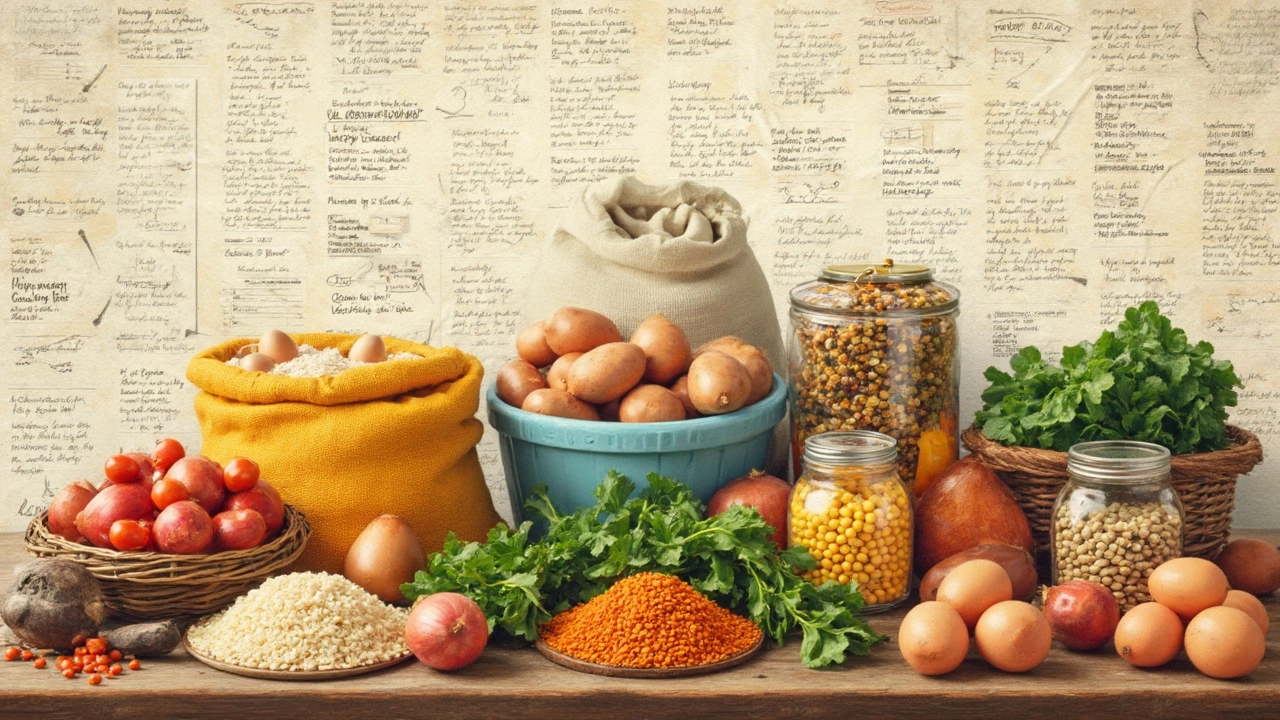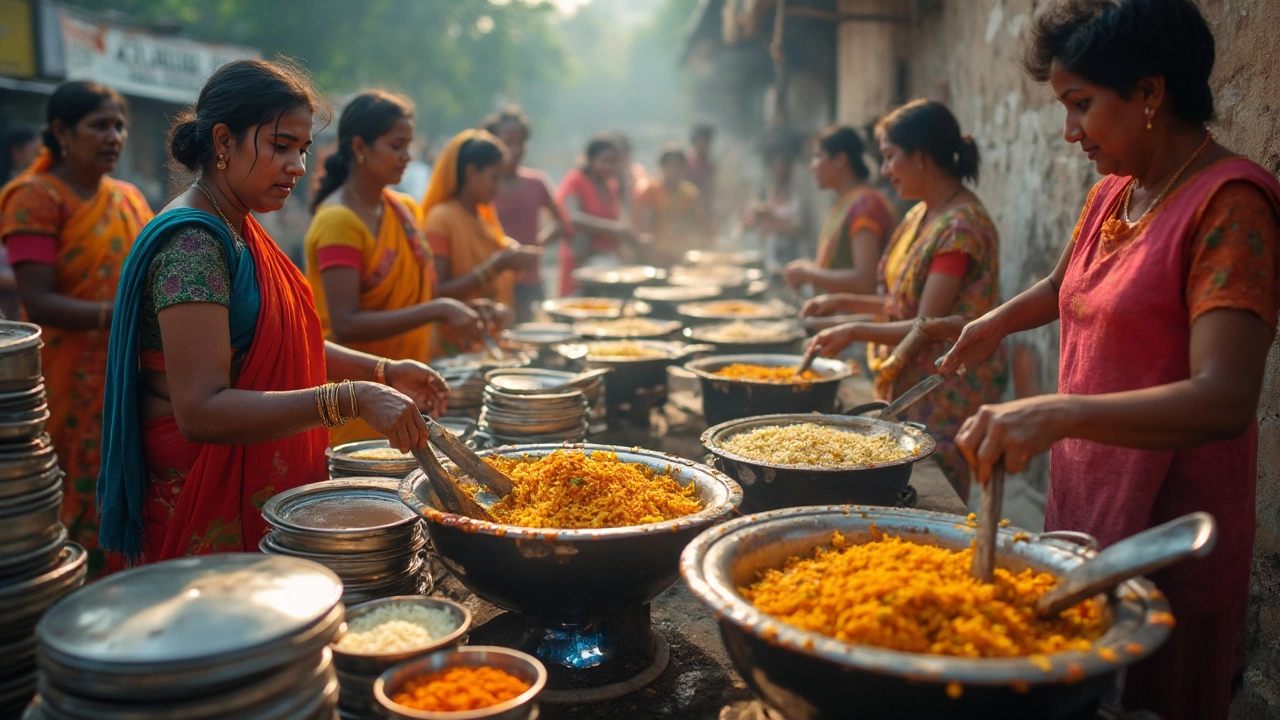If your fridge is looking empty and your budget’s tight, you’re not alone. Feeding a crowd can feel impossible when every penny counts. Food banks know this struggle all too well. They always lean on certain foods because they’re cheap, filling, and can be turned into gigantic meals without much fuss or fancy cooking skills.
Let’s get straight to what you want: what’s the absolute cheapest way to feed a lot of people? It’s not some weird substitute or mystery ingredient. It’s the basics—think rice, beans, pasta, potatoes, and oats. You’ve probably already guessed at least one of those. When you buy these staples in bulk, you get way more food for your money compared to prepared or packaged stuff.
The real game-changer is knowing how to make these simple foods taste good and keep people feeling full. My daughter Azura actually snoozes through lentil stew night, but Zephyr goes back for thirds. If you can cook one giant pot of something hearty and let everyone serve themselves, you’re already winning. Stock up when there’s a sale and don’t be afraid to experiment with flavors—you’ll stretch each dollar further than you thought possible.
- Why Food Banks Love Certain Foods
- Top Cheap Foods That Fill Bellies
- Smart Ways to Stretch Bulk Ingredients
- Easy Recipes for Feeding Groups
- Tips for Serving Big Without Stress
Why Food Banks Love Certain Foods
When you peek inside any food bank, you’ll notice the same ingredients show up over and over. It’s not a coincidence. Foods like rice, beans, pasta, and oats tick all the right boxes for feeding lots of people on the cheap. These foods last ages on the shelf, don’t need a fridge, and they’re a breeze to cook for beginners or busy volunteers. This is a lifesaver when you’re trying to serve a line that sometimes stretches out the door.
The price difference is huge. For example, a 10-pound bag of rice can turn into more than 50 servings, all for under $10 in many stores. That’s less than 20 cents a serving, which is wild compared to just about anything prepackaged.
- Cheapest food staples like beans and lentils are protein-packed and keep people full longer than chips or snack food.
- Whole grains and starches such as rice and pasta can be bought in massive bags, making it easier to plan big meals without breaking the bank.
- Canned veggies, tomatoes, and tuna are often added into food bank bags because they’re cheap, have a long shelf life, and boost basic meals with flavor and nutrition.
Here’s a quick look at some real numbers on why these basics matter at food banks:
| Food | Cost per Serving (US) | Storage | Shelf Life |
|---|---|---|---|
| White Rice | $0.16 | Panty/Dry | 4-5 years |
| Dry Beans | $0.12 | Panty/Dry | 2-3 years |
| Pasta | $0.18 | Panty/Dry | 1-2 years |
| Rolled Oats | $0.11 | Panty/Dry | 18-24 months |
| Canned Tomatoes | $0.25 | Panty | 18-24 months |
Food banks have to stretch every pound, dollar, and donation. That’s why they stick to options that are cheap, easy to hand out, and actually get people through the day. Extra bonus: almost anyone can cook them at home, even with just one pot on the stove or a microwave.
Top Cheap Foods That Fill Bellies
When you’re feeding a lot of people and your wallet is basically on life support, the secret is picking foods that are both filling and dirt cheap. Food banks count on these staples because they last a long time, fill you up, and make big portions for even just a few bucks. Here’s what actually works in real kitchens, not just on paper.
- Rice. White rice is usually the cheapest and sticks to your ribs. You can find huge bags at warehouse stores or international groceries, sometimes for under $0.20 a serving. Brown rice is a little healthier but takes longer to cook.
- Beans. Both dried and canned beans are nutrition powerhouses. Dried beans are cheaper by the pound, but canned beans are faster when you need backup in a hurry. They give fiber, protein, and can take on any flavor. Black beans, kidney, pinto, and lentils are all favorites.
- Pasta. There’s a reason pasta is basically everyone’s go-to when money’s tight. It’s cheap, quick to cook, and pairs with almost anything. A big pack can easily feed a crowd with just a simple sauce or even a sprinkle of cheese.
- Potatoes. Russets and Yukon Golds are top picks because they’re super filling. One 10-pound bag can turn into mashed potatoes, baked spuds, or skillet hash for a whole family … or your kid’s soccer team.
- Oats. If you need a breakfast that holds people over until lunch, nothing beats oats. Quick oats cook in a couple of minutes and cost just pennies per bowl. Add a handful of raisins or a spoonful of peanut butter for extra flavor and energy.
Not far behind are things like eggs (especially in big cartons), frozen veggies, and cabbage. Eggs are fantastic for bulking up pancakes, fried rice, or just making a huge tray of scrambled eggs. Cabbage is cheap, shreds up easily, and lasts forever in the fridge. These basics are what food banks hand out week after week—and for good reason. When you lean into these foods, you really can stretch every dollar and keep everyone fed.

Smart Ways to Stretch Bulk Ingredients
You’ve got a big bag of rice or a sack of potatoes sitting on your counter. Now what? The real trick is turning those basics into several filling meals without anyone getting bored (or complaining, if you’ve got picky eaters like Azura at home).
Food banks and soup kitchens rely on a few hacks to make every dollar and ingredient go further. The first secret: build meals around a starchy base, then throw in whatever extras you have—veggies, protein, or leftover bits. This way, you always end up with something satisfying.
Check out some smart moves for stretching those bulk staples:
- Cheapest food bulk buy: Stick to rice, beans, and pasta because they’re dirt cheap per serving. A 20-pound bag of rice usually costs less than $15 and makes over 200 servings.
- Mix and match: Combine different grains and beans for better flavor and texture. A split between white and brown rice or a blend of lentils and kidney beans adds variety without extra cost.
- Soups and stews: One big pot can feed a dozen people with just a few cups of rice, a handful of beans, and whatever veggies or scraps you’ve got. Add broth, water, and spices—the more liquid, the more servings you get.
- Double up veggies: Frozen and canned veggies are usually cheaper when bought in large quantities, plus they don’t spoil fast. Throw extra carrots or corn into your pot to bulk things up.
- Use leftovers: Stir leftover meat, veggies, or even scrambled eggs into rice or pasta to create a new meal. Nothing goes to waste.
When you break down the cost and servings, here’s what you get from common staples:
| Ingredient | Avg. Bulk Cost (USD) | Estimated Servings |
|---|---|---|
| White rice (20 lbs) | $14.50 | 200+ |
| Dried beans (10 lbs) | $13.00 | 120 |
| Pasta (10 lbs) | $10.00 | 80 |
| Potatoes (10 lbs) | $6.00 | 30 |
Seasonings matter too. Salt, garlic powder, and chili flakes are super cheap in bulk and can make any plain dish taste like you put in twice the effort. If you’re worried about running out of ideas, just look up "one-pot" recipes online—there’s a reason every food bank kitchen swears by them!
Easy Recipes for Feeding Groups
It’s not just about dumping beans and rice in a pot and hoping for the best. If you need to fill a bunch of plates and keep costs way down, picking the right recipes matters. You want simple, low-effort meals using ingredients you can buy cheap and in bulk. Here are a few favorites that show up all the time in community kitchens, food banks, and my own house.
- Rice and Bean Chili: This combo is a classic for a reason. You can make a huge batch with just rice, canned or dried beans, diced tomatoes, onions, and plenty of seasoning. Throw in chili powder, cumin, and garlic, and you’re set. A big slow cooker or giant pot makes everything easier. It serves a crowd, reheats well, and costs less than $1 per serving if you buy dry ingredients.
- Lentil Stew: Lentils cook faster than dried beans and are packed with protein. Sauté some onions, carrots, and celery, add lentils, canned tomatoes, cheap broth, and toss in whatever spices you’ve got. Simmer until thick. I’ve served this to thirty people for under $10 when prices are good.
- Pasta Bake: Food banks love pasta because you get a ton for a little. Boil your noodles, mix in tomato sauce, maybe some canned veggies or beans, top with the cheapest cheese you can find, and bake. A disposable tray can handle enough for a whole group, and cleanup is super fast.
- Sheet Pan Veggies and Potatoes: Cut potatoes, carrots, onions, and any other low-cost veg, toss with oil and seasonings, and roast on trays. Pair with beans or eggs if you have them. Every plate looks piled high—no one feels shortchanged.
- Oatmeal Bar: For a breakfast that actually fills people up, oats win every time. Cook them in bulk, then offer toppings like brown sugar, raisins, or any chopped fruit you find on clearance.
To show you how these choices stack up, here’s a quick look at the rough cost per serving (based on average U.S. grocery prices in early 2025):
| Recipe | Main Ingredients | Approx. Servings per $10 | Cost per Serving (USD) |
|---|---|---|---|
| Rice and Bean Chili | Rice, beans, tomatoes, onions | 16 | $0.63 |
| Lentil Stew | Lentils, veggies, broth | 18 | $0.56 |
| Pasta Bake | Pasta, tomato sauce, cheese | 14 | $0.71 |
| Sheet Pan Veggies & Potatoes | Potatoes, vegetables | 20 | $0.50 |
| Oatmeal Bar | Oats, toppings | 30 | $0.33 |
The real trick is keeping things flexible. Taste test seasonings—sometimes a splash of vinegar or a sprinkle of chili flakes totally changes a humble meal. Invite people to add their own toppings, too. Keeps everyone happier, especially picky eaters (Azura, I’m looking at you!). If you’re managing a cheapest food challenge for a whole group, prepping these recipes in advance makes it way less stressful on the big day.

Tips for Serving Big Without Stress
Serving huge batches of food sounds wild, but it actually gets easier with a few solid tricks up your sleeve. When you’re cooking for a crowd—especially with food bank donations or limited pantry staples—keep things simple, repeatable, and organized.
- Stick to One-Pot Wonders: Casseroles, stews, and giant trays of baked pasta save both time and stress. It’s way easier to manage one or two big pots than a bunch of side dishes.
- Go Heavy on Starches: Rice, pasta, and potatoes are super cheap and leave everyone feeling full. They’re easy to flavor using whatever odds and ends of sauce, cheese, canned veggies, or spices you’ve got.
- Prep Ahead: Chop your veggies and measure out dry goods the night before. If you’re using beans or lentils, soak them in advance; you’ll cut down both cooking time and hassle.
- Plan for Seconds: People pile on more than you expect. It’s safer to cook a little extra, especially when you’re dishing out crowd-pleasers.
- Simplify Serving: Use big serving spoons and let people help themselves; it cuts down lines and lets guests pick portions that fit them.
When portioning, food banks typically plan on about 1 to 1.5 cups of a main dish per adult. For side items like salad or bread, stick with half a cup to one cup per person. Here’s a quick cheat sheet for sizing your meal right:
| Item | Amount for 25 People | Amount for 50 People |
|---|---|---|
| Rice or Pasta | 5 lbs dry | 10 lbs dry |
| Beans (dry) | 3 lbs | 6 lbs |
| Canned Tomatoes/Sauce | 2 gallon cans | 4 gallon cans |
| Mixed Veggies | 6 lbs | 12 lbs |
| Bread | 3 loaves | 6 loaves |
Don’t stress about fancy presentation. Most folks just want hot, tasty, filling food, and they’ll remember the warm meal way more than matching napkins. When in doubt, pull out that big stock pot, trust your plan, and remember: feeding a crowd is all about community and stretching every bit of that cheapest food as far as it will go.





